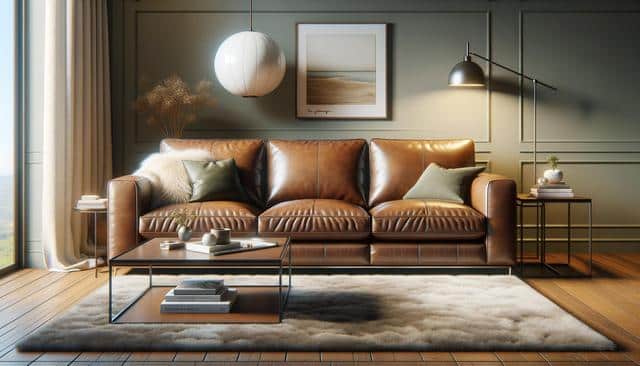Choosing the Perfect Leather Sofa for Your Living Room: A Style Guide
Find the perfect leather sofa for your living room with our expert guide. Explore various styles, colors, and designs that can elevate your home’s décor while ensuring comfort and durability. Shop smart and enhance your living room’s ambiance.

Understanding Leather Sofa Types
Before choosing a leather sofa for your living room, it’s important to understand the various types of leather used in furniture. Each type offers a different look, feel, and level of durability. Full-grain leather, for example, is known for its natural appearance and strength. It retains the hide’s natural surface, making it more resistant to wear. Top-grain leather is slightly more processed but still offers a smooth and luxurious texture. Then there’s split-grain and bonded leather, which are more affordable but may not offer the same level of longevity.
The type of leather you choose can influence the overall look and maintenance needs of your sofa. Here are a few things to consider when selecting leather:
- Full-grain: Natural look, ages well, high durability
- Top-grain: Smooth surface, slightly processed, softer texture
- Split-grain: Less expensive, requires more care
- Bonded leather: Budget-friendly, limited lifespan
Understanding these distinctions will help you select a leather sofa that suits your lifestyle, usage needs, and design preferences.
Popular Leather Sofa Styles
Leather sofas come in a wide range of styles, each contributing a unique feel to your living room. Whether you prefer a classic look or a modern aesthetic, there’s a design that complements your space. Traditional leather sofas often feature tufted backs, rolled arms, and rich, dark tones. These designs add a sense of elegance and timelessness to a room. On the other hand, contemporary leather sofas showcase clean lines, minimalistic shapes, and neutral colors, perfect for a modern or Scandinavian-inspired interior.
Here are some common styles to consider:
- Chesterfield: Deep button tufting, high arms, vintage appeal
- Mid-century modern: Sleek lines, tapered legs, minimalist design
- Sectional: L-shaped for larger spaces, often modular
- Recliner: Built-in footrests and adjustable backs for added comfort
Choosing the right style depends on your existing décor, room size, and the atmosphere you want to create. A well-chosen style can tie your whole living room together harmoniously.
Color and Finish Options
Color plays a significant role in the overall impact of your leather sofa. While black and brown are classic and versatile, modern homes often incorporate shades like white, gray, navy, or even bold hues like burgundy or forest green. Lighter tones can make a space feel open and airy, while darker shades add richness and warmth.
Finish is another key aspect—matte, semi-gloss, and high-gloss finishes all affect the appearance and texture of the leather. Matte finishes provide a more natural, understated look, while glossy finishes can feel more luxurious and contemporary. When choosing a color and finish, consider:
- Room lighting: Natural light enhances lighter tones
- Existing furniture: Choose complementary or contrasting colors
- Maintenance: Darker colors can hide stains better
By thoughtfully selecting your sofa’s color and finish, you can create a cohesive, stylish environment that supports both aesthetics and practicality.
Functionality and Comfort Considerations
While appearance is important, functionality and comfort should not be overlooked. A leather sofa should support your daily activities, whether you’re hosting guests, watching movies, or lounging with a book. Consider the sofa’s depth, cushion firmness, and seating capacity to ensure it meets your comfort needs.
Some functional elements to evaluate include:
- Cushion fill: Foam for firmness, down for softness, or a mix
- Support structure: Hardwood frames offer durability
- Reclining features: Ideal for relaxation and multi-use spaces
- Modular design: Useful for flexible seating arrangements
Additionally, the scale of the sofa should match your room size. A large sectional may overwhelm a small space, while a compact two-seater might not be sufficient for a bigger room. Comfort should go hand-in-hand with style to ensure you make the most of your investment.
Maintenance and Longevity
Leather sofas are known for their durability, but they still require proper care to maintain their appearance and function. Regular maintenance can significantly extend the lifespan of your furniture. Dust and vacuum your sofa weekly to prevent dirt buildup. Use a leather conditioner every 6-12 months to keep the material supple and prevent cracking.
Here are some key maintenance tips:
- Keep the sofa away from direct sunlight to avoid fading
- Wipe spills immediately with a soft, dry cloth
- Avoid harsh cleaners—use products specifically designed for leather
- Rotate cushions to ensure even wear
With these practices, your leather sofa can remain a centerpiece in your living room for years to come. Investing in quality and committing to regular care will ensure your furniture continues to look inviting and feel comfortable through daily use.
Conclusion: Elevate Your Living Room with a Thoughtful Choice
Selecting the right leather sofa involves balancing aesthetics, comfort, and practicality. By understanding leather types, exploring popular styles, assessing color options, and considering functionality, you can make an informed decision that enhances your living space. A well-chosen leather sofa not only serves as a focal point but also supports your lifestyle and design preferences. Take your time to explore options, compare materials, and envision how each piece fits into your home. With thoughtful planning, your living room can become a more stylish and comfortable place for you and your guests to enjoy.